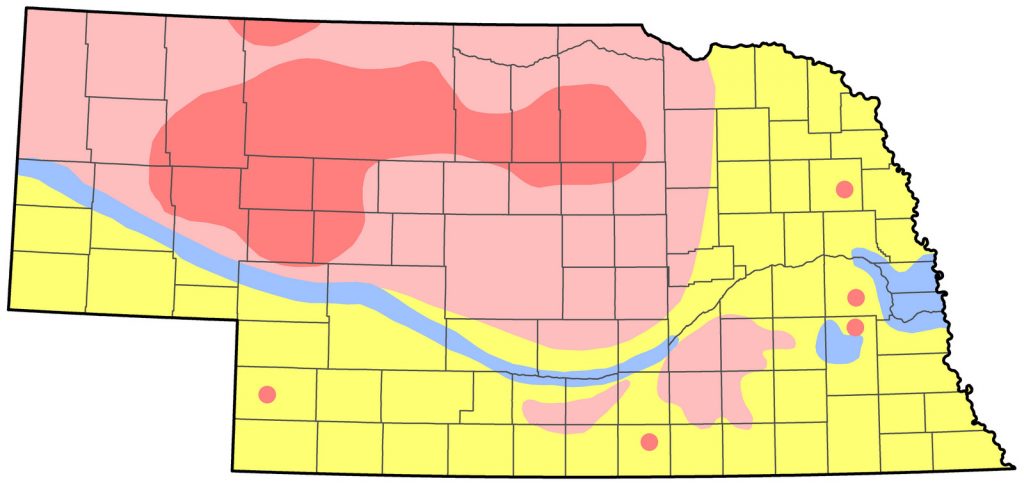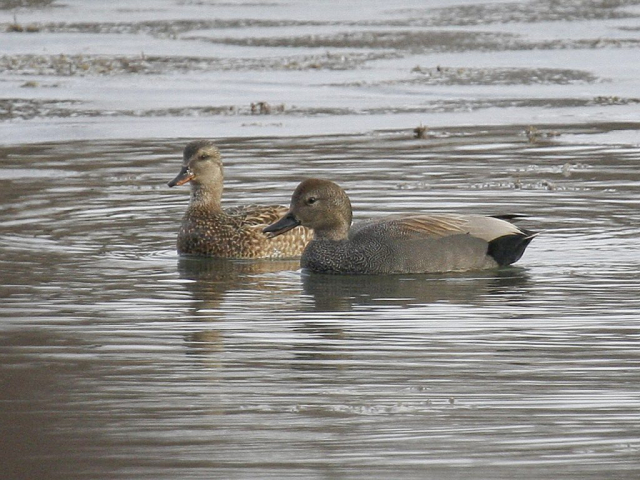Mareca strepera STREPERA
Status: Common, locally abundant, regular spring and fall migrant statewide. Common regular breeder north-central Nebraska and northern Panhandle, uncommon south-central, rare casual elsewhere. Uncommon regular winter visitor Platte, North Platte, South Platte, and lower Missouri River valley counties southward and Cedar and Knox Cos in the northeast, rare casual elsewhere.

Documentation: Specimen: KSC Olson #20, 20 Mar 1906 Kearney, Buffalo Co.
Taxonomy: Formerly two subspecies were recognized, strepera and central Pacific Tabuaeran (Fanning) Island couesi; the latter was extinct by 1874 (AviList 2025).
This species was recently moved from genus Anas to genus Mareca, based on genetic studies (Chesser et al 2017).
Occasionally Gadwall hybridizes with Northern Shoveler and Mallard; for Nebraska records, see Northern Shoveler x Gadwall (hybrid) and Gadwall x Mallard (hybrid).
Occasionally Gadwalls have been reported with white neck rings; one was in Knox Co 4 Apr 2024. This apparent variant also appears with a black neck ring or even both black and white neck rings on a single individual, and in many cases co-occurs with a chestnut wash on the head and neck, suggesting these characters may be linked (Harrison and Harrison 1963).
Spring: Feb 21, 21, 21 <<<>>> summer
Early dates above are away from the winter range; earlier such dates are 13 Feb 2018 Cedar Co, 17 Feb 2012 two in Garfield Co, and 17 Feb 2017 three in Cedar Co. These dates suggest northward movement beginning in mid- to late Feb, although first arrivals in numbers are typically seen in early Mar as open water becomes available. As many as 31 were in Cedar Co 5 Feb 2019 where only one had been present earlier. Numbers peak in early Apr, and migration is usually over by early May.
- High counts: 3500 at Lake McConaughy, Keith Co 30 Mar 2023, 3230 at Sutherland Reservoir, Lincoln Co 30 Mar 2023, 2600 at Crescent Lake NWR, Garden Co 15 Apr 1980, 1920 at Scottsbluff WTP, Scotts Bluff Co 15 Apr 2022, 1800 at Harvard WPA, Clay Co 9 Apr 2000, and 1750 at Crescent Lake NWR 23 Apr 1996.
Summer: Highest breeding densities occur in the Sandhills and to a much lesser extent the Rainwater Basin. In the Sandhills it was the fourth most common dabbling duck after Blue-winged Teal, Mallard, and Northern Shoveler; Vrtiska and Powell (2011) estimated for 2003-2005 an average annual total of 17,516 Gadwalls. A good summer count of 3000 were at Maverick Lake, Crescent Lake NWR 5 Aug 2021. Although Harding (1986) found 32 nests in Clay Co 1981-85, the third most common nester after Blue-winged Teal and Mallard, a hen and brood in York Co 16 Aug 2003 was the first evidence of Rainwater Basin breeding since 1985 (Jorgensen 2012).
Nesting reports away from the Sandhills and Rainwater Basin are few: Cuming Co (Wensien 1962), Dawes and Sioux Cos (Rosche 1982, Ducey 1988), Scotts Bluff Co, Lancaster Co (Cink 1971, Cink 1975), Saunders Co (Ducey 1988), and Webster Co (Wensien 1962).
Reports of pairs mid-Jun through mid-Jul away from the mapped summer range may indicate breeding.
- Breeding phenology:
Eggs: 5 May-14 Jul
Dependent fledglings: 13 May-27 Jul.
Fall: summer <<<>>> Dec 13, 13, 14
Late dates above are away from the winter range. Jul, Aug, and early Sep reports from areas where breeding did not occur are likely of molt migrants, which disperse in any direction, often for long distances (Palmer 1976). True migration becomes evident by late Sep; 200 were in Lincoln Co 14 Sep 2011. Migrating numbers peak in late Oct, although good numbers may be present well into Dec provided open water is available, usually within the winter range. As many as 575 were at Lake McConaughy, Keith Co 30-31 Dec 2011; in the east, 50 were still in Cedar Co as late as 26 Dec 1994. There are few reports after mid-Dec away from the winter range (see Winter).
- High counts: 5800 at Lake McConaughy, Keith Co 31 Oct 2006, 3000 at Lake Ogallala, Keith Co 11 Nov 2024, 2200 at Crescent Lake NWR 9 Oct 1996, and 2030 in Lancaster Co 3 Nov 1998.
Winter: This species usually over-winters in the Platte, North Platte, South Platte, and lower Missouri River valley counties southward given open water conditions. Since 2012, the Gavin’s Point Dam area, Cedar and Knox Cos, has become a wintering location; best counts there are 29 on 15-17 Jan 2022 and 75 on 20 Jan 2025. The only records elsewhere in mid-winter (Jan-10 Feb) are 1 Jan 2024 and 9 Jan 2020 Madison Co, 24 Jan 2025 (11) Grove Lake, Antelope Co, 25 Jan 2020 Loup Co, and 4 Feb 2025 (2) Lovitt Lake, Logan Co.
Previously, only small numbers wintered, but more recently these numbers have increased. Best counts are 75 at Gavin’s Point Dam, Cedar Co 20 Jan 2025, 24 at Scottsbluff SL 14 Jan 2016 and 16 there 23 Jan 2015 increasing to 27 on 13 Feb as migrants began arriving.
- High counts: 500 at Lake Ogallala 2 Jan 2025, 373 there 29 Jan 2000, and 75 at Gavin’s Point Dam, Cedar Co 20 Jan 2025.
Images
Abbreviations
KSC: Kearney State College (now University of Nebraska-Kearney)
NWR: National Wildlife Refuge
SL: Sewage Lagoons
SP: State Park
WMA: Wildlife Management Area (State)
WPA: Waterfowl Production Area (Federal)
WTP: Water Treatment Plant
Literature Cited
AviList Core Team, 2025. AviList: The Global Avian Checklist, v2025. https://doi.org/10.2173/avilist.v2025.
Chesser, R.T., K.J. Burns, C. Cicero, J.L. Dunn, A.W. Kratter, I.J. Lovette, P.C. Rasmussen, J. V. Remsen, Jr., J.D. Rising, D.F. Stotz, and K. Winker. 2017. Fifty-eighth supplement to the American Ornithological Society’s Check-list of North American Birds. Auk 134: 751-773.
Cink, C.L. 1971. Some interesting summer bird records for Lancaster County in 1970. NBR 39:58-59.
Cink, C.L. 1975. Some waterfowl breeding records for Lancaster County. NBR 43: 40-41.
Ducey, J.E. 1988. Nebraska birds, breeding status and distribution. Simmons-Boardman Books, Omaha, Nebraska, USA.
Harding, R.G. 1986. Waterfowl nesting preferences and productivity in the Rainwater Basin, Nebraska. Master’s thesis, Kearney State College, Kearney, Nebraska.
Harrison, J.M., and J.G. Harrison. 1963. A Gadwall with a white neck ring and a review of plumage variants in waterfowl. Bulletin of the British Ornithological Club 83: 101-108.
Jorgensen, J.G. 2012. Birds of the Rainwater Basin, Nebraska. Nebraska Game and Parks Commission, Lincoln, Nebraska, USA.
Palmer, R.S., ed. 1976. Handbook of North American birds. Vol. 2. Waterfowl (Parts 1 and 2). Yale University Press, New Haven, Connecticut, USA.
Rosche, R.C. 1982. Birds of northwestern Nebraska and southwestern South Dakota, an annotated checklist. Cottonwood Press, Crawford, Nebraska, USA.
Vrtiska, M.P., and L. Powell. 2011. Estimates of Duck Breeding Populations in the Nebraska Sandhills Using Double Observer Methodology. Waterbirds 34: 96-101.
Wensien, R. 1962. Nesting report, 1961. NBR 30: 24-25.
Recommended Citation
Silcock, W.R., and J.G. Jorgensen. 2025. Gadwall (Mareca strepera). In Birds of Nebraska — Online. www.BirdsofNebraska.org
Birds of Nebraska – Online
Updated 5 Jul 2025

